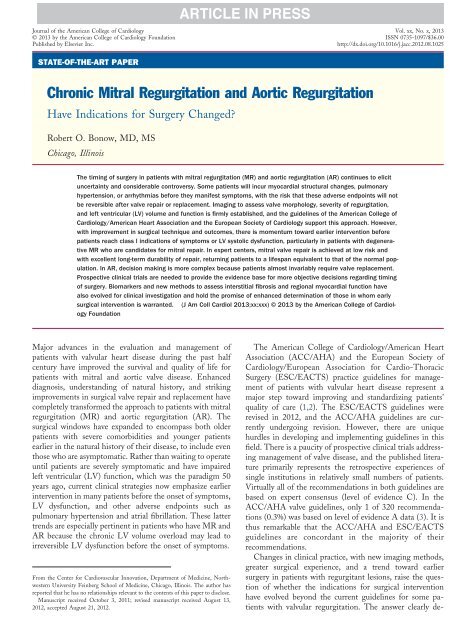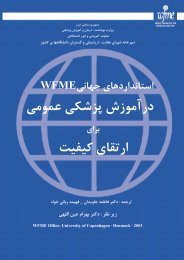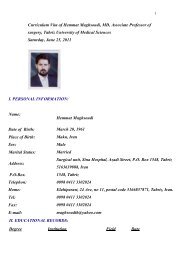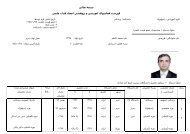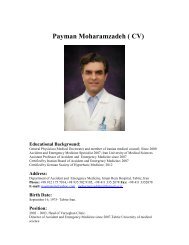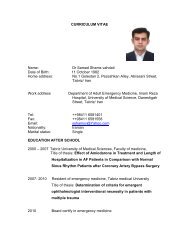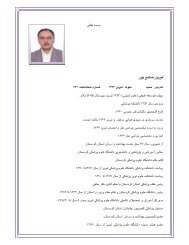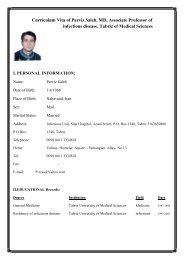Chronic Mitral Regurgitation and Aortic Regurgitation
Chronic Mitral Regurgitation and Aortic Regurgitation
Chronic Mitral Regurgitation and Aortic Regurgitation
- No tags were found...
Create successful ePaper yourself
Turn your PDF publications into a flip-book with our unique Google optimized e-Paper software.
Journal of the American College of Cardiology Vol. xx, No. x, 2013<br />
© 2013 by the American College of Cardiology Foundation ISSN 0735-1097/$36.00<br />
Published by Elsevier Inc.<br />
http://dx.doi.org/10.1016/j.jacc.2012.08.1025<br />
STATE-OF-THE-ART PAPER<br />
<strong>Chronic</strong> <strong>Mitral</strong> <strong>Regurgitation</strong> <strong>and</strong> <strong>Aortic</strong> <strong>Regurgitation</strong><br />
Have Indications for Surgery Changed<br />
Robert O. Bonow, MD, MS<br />
Chicago, Illinois<br />
The timing of surgery in patients with mitral regurgitation (MR) <strong>and</strong> aortic regurgitation (AR) continues to elicit<br />
uncertainty <strong>and</strong> considerable controversy. Some patients will incur myocardial structural changes, pulmonary<br />
hypertension, or arrhythmias before they manifest symptoms, with the risk that these adverse endpoints will not<br />
be reversible after valve repair or replacement. Imaging to assess valve morphology, severity of regurgitation,<br />
<strong>and</strong> left ventricular (LV) volume <strong>and</strong> function is firmly established, <strong>and</strong> the guidelines of the American College of<br />
Cardiology/American Heart Association <strong>and</strong> the European Society of Cardiology support this approach. However,<br />
with improvement in surgical technique <strong>and</strong> outcomes, there is momentum toward earlier intervention before<br />
patients reach class I indications of symptoms or LV systolic dysfunction, particularly in patients with degenerative<br />
MR who are c<strong>and</strong>idates for mitral repair. In expert centers, mitral valve repair is achieved at low risk <strong>and</strong><br />
with excellent long-term durability of repair, returning patients to a lifespan equivalent to that of the normal population.<br />
In AR, decision making is more complex because patients almost invariably require valve replacement.<br />
Prospective clinical trials are needed to provide the evidence base for more objective decisions regarding timing<br />
of surgery. Biomarkers <strong>and</strong> new methods to assess interstitial fibrosis <strong>and</strong> regional myocardial function have<br />
also evolved for clinical investigation <strong>and</strong> hold the promise of enhanced determination of those in whom early<br />
surgical intervention is warranted. (J Am Coll Cardiol 2013;xx:xxx) © 2013 by the American College of Cardiology<br />
Foundation<br />
Major advances in the evaluation <strong>and</strong> management of<br />
patients with valvular heart disease during the past half<br />
century have improved the survival <strong>and</strong> quality of life for<br />
patients with mitral <strong>and</strong> aortic valve disease. Enhanced<br />
diagnosis, underst<strong>and</strong>ing of natural history, <strong>and</strong> striking<br />
improvements in surgical valve repair <strong>and</strong> replacement have<br />
completely transformed the approach to patients with mitral<br />
regurgitation (MR) <strong>and</strong> aortic regurgitation (AR). The<br />
surgical windows have exp<strong>and</strong>ed to encompass both older<br />
patients with severe comorbidities <strong>and</strong> younger patients<br />
earlier in the natural history of their disease, to include even<br />
those who are asymptomatic. Rather than waiting to operate<br />
until patients are severely symptomatic <strong>and</strong> have impaired<br />
left ventricular (LV) function, which was the paradigm 50<br />
years ago, current clinical strategies now emphasize earlier<br />
intervention in many patients before the onset of symptoms,<br />
LV dysfunction, <strong>and</strong> other adverse endpoints such as<br />
pulmonary hypertension <strong>and</strong> atrial fibrillation. These latter<br />
trends are especially pertinent in patients who have MR <strong>and</strong><br />
AR because the chronic LV volume overload may lead to<br />
irreversible LV dysfunction before the onset of symptoms.<br />
From the Center for Cardiovascular Innovation, Department of Medicine, Northwestern<br />
University Feinberg School of Medicine, Chicago, Illinois. The author has<br />
reported that he has no relationships relevant to the contents of this paper to disclose.<br />
Manuscript received October 3, 2011; revised manuscript received August 13,<br />
2012, accepted August 21, 2012.<br />
The American College of Cardiology/American Heart<br />
Association (ACC/AHA) <strong>and</strong> the European Society of<br />
Cardiology/European Association for Cardio-Thoracic<br />
Surgery (ESC/EACTS) practice guidelines for management<br />
of patients with valvular heart disease represent a<br />
major step toward improving <strong>and</strong> st<strong>and</strong>ardizing patients’<br />
quality of care (1,2). The ESC/EACTS guidelines were<br />
revised in 2012, <strong>and</strong> the ACC/AHA guidelines are currently<br />
undergoing revision. However, there are unique<br />
hurdles in developing <strong>and</strong> implementing guidelines in this<br />
field. There is a paucity of prospective clinical trials addressing<br />
management of valve disease, <strong>and</strong> the published literature<br />
primarily represents the retrospective experiences of<br />
single institutions in relatively small numbers of patients.<br />
Virtually all of the recommendations in both guidelines are<br />
based on expert consensus (level of evidence C). In the<br />
ACC/AHA valve guidelines, only 1 of 320 recommendations<br />
(0.3%) was based on level of evidence A data (3). It is<br />
thus remarkable that the ACC/AHA <strong>and</strong> ESC/EACTS<br />
guidelines are concordant in the majority of their<br />
recommendations.<br />
Changes in clinical practice, with new imaging methods,<br />
greater surgical experience, <strong>and</strong> a trend toward earlier<br />
surgery in patients with regurgitant lesions, raise the question<br />
of whether the indications for surgical intervention<br />
have evolved beyond the current guidelines for some patients<br />
with valvular regurgitation. The answer clearly de-
2 Bonow JACC Vol. xx, No. x, 2013<br />
Surgery for Valvular <strong>Regurgitation</strong><br />
Month 2013:xxx<br />
Abbreviations<br />
<strong>and</strong> Acronyms<br />
ACC American College of<br />
Cardiology<br />
AHA American Heart<br />
Association<br />
AR aortic regurgitation<br />
pends on the experience of the<br />
referring cardiologist <strong>and</strong> the expertise<br />
of the surgical team. A<br />
“reasonable” Class IIa guideline<br />
recommendation has different<br />
interpretations <strong>and</strong> implications<br />
in various settings.<br />
AVR aortic valve<br />
replacement<br />
CABG coronary artery<br />
bypass graft<br />
EACTS European<br />
Association for Cardio-<br />
Thoracic Surgery<br />
ESC European Society of<br />
Cardiology<br />
LV left ventricular<br />
MR mitral regurgitation<br />
MV mitral valve<br />
MVP mitral valve<br />
prolapse<br />
STS Society of Thoracic<br />
Surgeons<br />
Degenerative MR<br />
Class I recommendations for<br />
surgery in the ACC/AHA <strong>and</strong><br />
ESC/EACTS guidelines (1,2)<br />
for patients with degenerative<br />
MR (predominantly mitral valve<br />
prolapse [MVP] from myxomatous<br />
disease <strong>and</strong> fibroelastic deficiency)<br />
include patients with<br />
symptoms <strong>and</strong> those with<br />
asymptomatic LV systolic dysfunction<br />
(Table 1). Because LV<br />
shortening may be enhanced in<br />
the setting of severe MR by the<br />
ability to unload into the lowimpedance<br />
left atrium, LV dysfunction<br />
in severe MR is defined as an ejection fraction<br />
60% or an elevated end-systolic dimension. Surgery is also<br />
reasonable (class IIa) for patients who have pulmonary<br />
hypertension at rest or new-onset atrial fibrillation if they<br />
are c<strong>and</strong>idates for mitral valve (MV) repair. Exercise testing<br />
is helpful in many situations (4) for determining if a patient<br />
is truly asymptomatic <strong>and</strong> in identifying those who develop<br />
pulmonary hypertension with exercise (60 mm Hg) (1,2).<br />
These indications for MV surgery are reasonable if a<br />
patient presents initially to the cardiologist with any of these<br />
findings. However, in the longitudinal management of<br />
asymptomatic patients with severe MR, would it be preferable<br />
for patients to undergo surgery before these endpoints<br />
Guideline Surgery for Recommendations Degenerative Guideline Recommendations <strong>Mitral</strong> for <strong>Regurgitation</strong> for<br />
Table 1<br />
Surgery for Degenerative <strong>Mitral</strong> <strong>Regurgitation</strong><br />
Indication ACC/AHA ESC/EACTS<br />
Symptomatic patients Class I Class I<br />
Asymptomatic patients<br />
LV systolic dysfunction* Class I Class I<br />
Pulmonary hypertension<br />
PASP 50 mm Hg at rest Class IIa Class IIa<br />
PASP 60 mm Hg with exercise Class IIa Class IIb<br />
Atrial fibrillation Class IIa Class IIa<br />
Normal LV function, repair feasible Class IIa Class IIa†<br />
This is a simplified table. See full guidelines (1,2) for complete recommendations.<br />
*Defined as ejection fraction 60% or elevated end-systolic diameter (40 mm in ACC/AHA<br />
guidelines; 45 mm in ESC/EACTS guidelines). †Specifically for patients with flail leaflet <strong>and</strong><br />
end-systolic dimension 40 mm; there is a separate class IIb recommendation for such patients<br />
with left atrial volume index 60 ml/m 2 .<br />
ACC/AHA American College of Cardiology/American Heart Association; ESC/EACTS European<br />
Society of Cardiology/European Association for Cardio-Thoracic Surgery; LV left ventricular;<br />
PASP pulmonary artery systolic pressure.<br />
Figure 1 <strong>Mitral</strong> Valve Repair 2000 to 2007<br />
Percentage of patients in the Society of Thoracic Surgeons Database undergoing<br />
mitral valve repair for primary mitral regurgitation from 2000 through 2007.<br />
Data include 47,126 patients at 910 hospitals. Patients with mitral stenosis,<br />
endocarditis, previous cardiac surgery, shock, emergency surgery, <strong>and</strong> concomitant<br />
coronary artery bypass graft or aortic valve surgery are excluded.<br />
Reprinted, with permission, from Gammie et al. (5).<br />
develop, because LV dysfunction, pulmonary hypertension,<br />
or atrial fibrillation is not always reversible after surgery<br />
This question frames the debate whether all asymptomatic<br />
patients with MVP <strong>and</strong> chronic severe MR should undergo<br />
elective MV repair. This dilemma can only be settled with<br />
a prospective r<strong>and</strong>omized trial of elective MV repair versus<br />
a strategy of “watchful waiting.”<br />
One concern about a broad recommendation for MV<br />
surgery in all asymptomatic patients with MVP <strong>and</strong> severe<br />
MR in the United States is that many might be subject to<br />
the long-term risks of prosthetic valves when they are<br />
excellent c<strong>and</strong>idates for MV repair. According to the<br />
database of the Society of Thoracic Surgeons (STS) (5), the<br />
frequency of MV repair for patients with MR in North<br />
America, after excluding patients with mitral stenosis endocarditis,<br />
emergency surgery, previous heart surgery, <strong>and</strong><br />
concomitant coronary artery bypass graft (CABG) or aortic<br />
valve surgery, has increased during the last decade but has<br />
plateaued at just less than 70% (Fig. 1). Because the great<br />
majority of such operations are for MVP or functional MR,<br />
one would anticipate that a higher percentage of patients are<br />
c<strong>and</strong>idates for MV repair.<br />
The frequency of repair is just one aspect of the issue;<br />
there are no data regarding the actual success rates of MV<br />
repair in the United States in terms of elimination of MR.<br />
Residual MR at hospital discharge has adverse implications<br />
regarding the longevity of the repair <strong>and</strong> the likelihood that<br />
additional surgery may be necessary (6). In addition, despite<br />
excellent durability of a successful repair in most patients,<br />
there is the risk of recurrent MR over the long term (6–9).<br />
Assuming that a high-volume, high-quality surgical center<br />
can provide asymptomatic patients who have MVP <strong>and</strong><br />
severe MR with successful repair more than 95% of the time
JACC Vol. xx, No. x, 2013<br />
Month 2013:xxx<br />
Bonow<br />
Surgery for Valvular <strong>Regurgitation</strong><br />
3<br />
Mortality With Degenerative of Asymptomatic Mortality MRofWithout Asymptomatic Patients Surgery Patients<br />
Table 2<br />
With Degenerative MR Without Surgery<br />
Mortality<br />
Rate<br />
Mean<br />
Age<br />
Mean<br />
LVEDD<br />
First Author (Ref. £) No. of Patients<br />
Enriquez-Sarano Severe MR 198 8.4%/yr 61 yrs 61 mm<br />
et al. (11)<br />
Moderate MR 129 6.7%/yr 65 yrs 54 mm<br />
Rosenhek et al. (12) 132 0%/yr* 55 yrs 56 mm<br />
Grigioni et al. (13) 394 2.8%/yr 64 yrs 59 mm<br />
Kang et al. (14) 286 0.7%/yr 50 yrs 57 mm<br />
*Two deaths occurred in patients who fulfilled guideline criteria for surgery but refused the<br />
operation.<br />
LVEDD left ventricular end-diastolic dimension; MR mitral regurgitation.<br />
(10), the question then shifts from feasibility of MV repair<br />
to clinical outcomes of a strategy of early MV repair.<br />
Because MV repair will not improve symptoms in truly<br />
asymptomatic patients, the issue is whether it will improve<br />
long-term survival.<br />
There are conflicting data regarding whether patients<br />
with asymptomatic severe degenerative MR are at risk of<br />
death before they develop the objective class I or IIa<br />
indications for surgery. Four studies that observed asymptomatic<br />
patients with severe degenerative MR have reported<br />
markedly divergent findings regarding the risk of death in<br />
those who are not referred for surgery (Table 2), with annual<br />
mortality rates ranging from 0% to 8% per year (11–14). It<br />
is noteworthy that the study reporting the highest mortality<br />
rate (11) was a retrospective analysis of patients enrolled<br />
between 1991 <strong>and</strong> 2000; these patients were managed by<br />
their referring physicians <strong>and</strong> not the study investigators,<br />
with many of them enrolled before the same investigators<br />
had published their seminal papers describing the predictors<br />
of outcome <strong>and</strong> before publication of the first ACC/AHA<br />
guidelines in 1998. In contrast, the study with the lowest<br />
mortality rate (12) followed patients prospectively <strong>and</strong> used<br />
guideline recommendations as the only indications for<br />
surgery. The 2 deaths related to MR in that study occured<br />
in patients who fulfilled the criteria for surgery but refused<br />
to undergo the operation. Although it is true that the 2<br />
series reporting the higher mortality rates (11,13) studied<br />
patients who were older <strong>and</strong> had more severe LV dilation<br />
(as a marker of severity of MR), these differences in<br />
mortality among the 4 studies are not readily rationalized.<br />
However, all 4 studies are consistent, <strong>and</strong> in keeping with<br />
the earlier data of Rosen et al. (15), in demonstrating that<br />
the rate at which patients with asymptomatic severe MR<br />
develop symptoms or other objective indications for MV<br />
surgery is relatively fast, with 30% to 40% of patients<br />
achieving an indication for surgery over a 5-year period (Fig.<br />
2). Moreover, Enriquez-Sarano et al. (11) quantified severity<br />
of MR according to the current recommendations of the<br />
American Society of Echocardiography (16) <strong>and</strong> showed<br />
that in asymptomatic patients with severe MR (defined as<br />
an effective regurgitant orifice area 0.4 cm 2 ), the likelihood<br />
of remaining alive <strong>and</strong> asymptomatic without heart<br />
failure or atrial fibrillation was only 36% at 5 years. Thus,<br />
independent of whether asymptomatic patients with severe<br />
MR are at risk of dying, the majority will develop indications<br />
for surgery within only a few years.<br />
Although the risk of death before surgery is debatable, a<br />
stronger argument for earlier surgery for severe MR can be<br />
made based on the survival results after MV surgery.<br />
Survival results after MV repair are significantly related to<br />
the presence <strong>and</strong> severity of preoperative symptoms. Postoperative<br />
survival is equivalent to that of age- <strong>and</strong> sexmatched<br />
normal subjects in patients who are categorized as<br />
New York Heart Association functional class I or II<br />
preoperatively, whereas survival is significantly lower than<br />
expected in patients who have developed New York Heart<br />
Association functional class III or IV symptoms before<br />
surgery (7,17). It follows that if surgery is delayed until<br />
patients exhibit significant symptoms, many will have developed<br />
LV dysfunction, pulmonary hypertension, <strong>and</strong>/or<br />
atrial fibrillation that may not be reversible <strong>and</strong> will affect<br />
survival adversely after otherwise successful MV repair.<br />
Thus, it is not unreasonable to consider elective MV repair<br />
as a treatment option, in patients who are c<strong>and</strong>idates for<br />
repair, if it can be performed in a center with a high<br />
likelihood of success <strong>and</strong> at low risk.<br />
On the basis of these considerations, the ACC/AHA<br />
guidelines (1) conclude that it is reasonable to consider<br />
(Class IIa) MV repair in asymptomatic patients with severe<br />
MR in whom the likelihood of successful repair without<br />
residual MR is 90%, although the ESC/EACTS guidelines<br />
(2) recommend repair only in patients with a flail<br />
leaflet <strong>and</strong> an LV end-systolic dimension 40 mm (class<br />
IIa) or those with left atrial dilation 60 ml/m 2 (class IIb).<br />
The stronger class I statement in both guidelines is that MV<br />
repair is preferrable to MV replacement in patients with<br />
MR who require surgery (1,2), <strong>and</strong> that patients should be<br />
referred to surgical centers experienced in MV repair (1).<br />
With the underst<strong>and</strong>ing that there are no prospective trials<br />
Figure 2<br />
Natural History of Degenerative <strong>Mitral</strong> <strong>Regurgitation</strong><br />
Natural history of asymptomatic patients with degenerative mitral regurgitation<br />
<strong>and</strong> normal left ventricular systolic function. Data from Enriquez-Sarano et al.<br />
(11), Rosenhek et al. (12), Grigioni et al. (13), Kang et al. (14), Rosen et al.<br />
(15).
4 Bonow JACC Vol. xx, No. x, 2013<br />
Surgery for Valvular <strong>Regurgitation</strong><br />
Month 2013:xxx<br />
Figure 3<br />
Hospital Volume of <strong>Mitral</strong> Valve Surgery<br />
<strong>and</strong> Outcomes<br />
Data linking volume of mitral valve surgery to in-hospital mortality <strong>and</strong> the frequency<br />
of mitral valve repair. Data include 13,614 patients at 575 hospitals.<br />
Hospitals are divided into quartiles of mitral valve surgery volume, with mortality<br />
at the lowest-volume centers set at 1.0. Patients with mitral stenosis, previous<br />
cardiac surgery, shock, recent myocardial infarction, <strong>and</strong> concomitant<br />
surgery (other than tricuspid valve procedures) are excluded. Reprinted, with<br />
permission, from Gammie et al. (21).<br />
the highest volume decile (Fig. 4). These data at the<br />
hospital level do not provide insights into outcomes of the<br />
individual cardiac surgeon. However, Bolling et al. (23) have<br />
tied procedural volume of individual surgeons performing<br />
MV surgery to the likelihood of MV repair versus replacement.<br />
Among 1,008 surgeons performing 28,507 MV<br />
operations from 2007 to 2009 at 639 North American<br />
hospitals in the STS Database, those performing a higher<br />
volume of MV operations performed a higher percentage of<br />
MV repairs. A striking finding in these data was that only 3<br />
surgeons peformed more than 100 MV operations per year<br />
<strong>and</strong> only 16 performed more than 50 per year. The median<br />
number of MV operations was only 5 per surgeon per year<br />
(range 1 to 166), <strong>and</strong> the mean rate of MV repair was only<br />
41% (range 0% to 100%). Thus, at both the hospital <strong>and</strong> the<br />
provider level, there is strong evidence of variability in<br />
surgical treatment, with the majority of patients undergoing<br />
surgery by low-volume operators with a high likelihood of<br />
receiving MV replacement instead of repair. Whether there<br />
are volume thresholds or variations in care at the level of the<br />
individual surgeon that translate into disparate survival<br />
outcomes (as has been shown at the hospital level) will<br />
require further study.<br />
Bridgewater et al. (24) addressed the concept of centers of<br />
excellence for MV surgery; recommended development of<br />
multidisciplinary teams of surgeons, cardiologists, anesthesiologists,<br />
<strong>and</strong> nurses; <strong>and</strong> proposed 19 best practices for<br />
MV repair. These criteria focus on surgical training, quality<br />
control, <strong>and</strong> patient volume at the hospital <strong>and</strong> surgeon<br />
level. Whether the volume thesholds they proposed (50 per<br />
year for the hospital <strong>and</strong> 25 per year for the surgeon) are<br />
possible in light of the data of Bolling et al. noted earlier<br />
(23) is questionable. More important than volume alone,<br />
auditing of surgical results was emphasized, with proposed<br />
targets of 1% operative mortality <strong>and</strong> 5% five-year<br />
comparing MV repair with replacement, the majority of<br />
comparative studies indicate a survival advantage with repair<br />
(8,18–20).<br />
Although the criteria for an “experienced” surgical center<br />
were not defined, there are data supporting the concept that<br />
centers of excellence in MV surgery yield better patient<br />
outcomes. Findings from the STS Database (21) demonstrate<br />
that volume of MR surgery at the hospital level<br />
(excluding patients who have mitral stenosis, previous cardiac<br />
surgery, shock, or recent myocardial infarction <strong>and</strong><br />
those undergoing concomitant surgery except procedures on<br />
the tricuspid valve) was significantly related to in-hospital<br />
mortality after MV surgery, which in turn is related to the<br />
likelihood that patients receive MV repair instead of replacement<br />
(Fig. 3). Although hospital volume is only a<br />
rough surrogate for quality, similar outcomes have been<br />
observed in Medicare data (22), with in-hospital mortality<br />
rates after MV surgery twice as high in centers in the lowest<br />
decile of surgical volume compared with that in centers in<br />
Figure 4<br />
Hospital Volume <strong>and</strong><br />
Outcome of <strong>Mitral</strong> Valve Replacement<br />
Relationship between hospital volume <strong>and</strong> in-hospital mortality for mitral valve<br />
replacement in patients enrolled in Medicare, including 61,252 mitral valve<br />
operations in 684 U.S. hospitals. From Goodney<br />
et al. (22).
JACC Vol. xx, No. x, 2013<br />
Month 2013:xxx<br />
Bonow<br />
Surgery for Valvular <strong>Regurgitation</strong><br />
5<br />
reoperation rates (24). This underscores the principal that a<br />
low-volume center can still be a high-quality center if there<br />
is attention to quality. Finally, quality control of cardiology<br />
practice, echocardiography, <strong>and</strong> intraoperative<br />
transesophogeal echocardiography was also emphasized.<br />
With or without a m<strong>and</strong>ate for centers of excellence for<br />
MV surgery, there is also evidence of variability in physician<br />
adherence to accepted recommendations for optimal patient<br />
management, including large numbers of patients with<br />
symptomatic MR who are not referred for surgery (25–27).<br />
At a time when there are strong currents toward earlier<br />
surgery in asymptomatic patients with MR, there needs to<br />
be renewed emphasis on the clear class I recommendations<br />
for surgery in symptomatic patients.<br />
Functional MR<br />
Guideline for SurgeryRecommendations<br />
for Guideline Functional Recommendations<br />
MR<br />
Table 3<br />
for Surgery for Functional MR<br />
Indication ACC/AHA ESC/EACTS<br />
Severe MR, EF 30%, undergoing CABG<br />
Class I<br />
Moderate MR, undergoing CABG<br />
Class IIa<br />
Severe MR, EF 30%, option for CABG <strong>and</strong><br />
evidence of viability<br />
Class IIa<br />
Severe MR, EF 30%, no option for CABG,<br />
symptoms desipte optimal medical<br />
therapy (including CRT), low comorbidity<br />
Severe MR, EF 30%, NYHA FC III-IV<br />
symptoms desipte optimal medical<br />
therapy (including CRT)<br />
Functional MR stemming from LV dilation <strong>and</strong> remodeling<br />
occurs commonly in patients with ischemic or dilated<br />
cardiomyopathy <strong>and</strong> is the second leading cause of MR in<br />
the United States <strong>and</strong> developed countries of the world (28).<br />
Because this is a disease of the myocardium <strong>and</strong> not the<br />
valve itself, uncertainty exists regarding the indications for<br />
primary MV surgery.<br />
Current evidence clearly indicates that the presence of<br />
functional MR identifies a higher risk group among patients<br />
with LV systolic dysfunction <strong>and</strong> that increasing severity of<br />
MR adds incrementally to this risk (29,30). Although mild<br />
MR in patients with primary degenerative MR is well<br />
tolerated for years, even mild functional MR in a patient<br />
with a low ejection fraction has important adverse prognostic<br />
implications. What is less clear is whether functional MR<br />
is merely a marker of severity of LV dysfunction or whether<br />
its attendant volume load contributes to progressive LV<br />
dysfunction <strong>and</strong> is thus a target for therapy.<br />
Therapies that produce beneficial reverse LV remodeling<br />
<strong>and</strong> reduction in LV volume, such as beta-adrenergic<br />
blockade or cardiac resynchronization therapy, reduce the<br />
severity of functional MR (31–33) <strong>and</strong> also improve outcomes<br />
in terms of survival <strong>and</strong> quality of life. It does not<br />
necessarily follow that interventions primarily targeted to<br />
reduce MR will have similar beneficial effects in addition to,<br />
or instead of, optimal medical therapy. To the best of my<br />
knowledge, there are no prospective studies demonstrating<br />
this effect. A retrospective study using propensity analyses<br />
failed to show a benefit of surgery compared with medical<br />
treatment of functional MR (34), <strong>and</strong> another study failed<br />
to show any benefit of CABG plus MV repair compared<br />
with CABG alone in patients with ischemic functional MR<br />
(35). Moreover, unlike repair of degenerative MR, in which<br />
successful repair has established durability for decades<br />
(7,8,36), functional MR commonly recurs after intially<br />
successful MV repair because of the progressive nature of<br />
the underlying ventricular disease (37). This situation creates<br />
the additional uncertainty of whether the more advantageous<br />
surgical approach to functional MR is MV replacement<br />
instead of MV repair.<br />
The National Heart, Lung, <strong>and</strong> Blood Institute’s Cardiothoracic<br />
Surgical Trials Network is addressing several of<br />
these surgical issues through its 2 ongoing clinical trials of<br />
surgical treatment of functional MR (38). However, neither<br />
of these trials compares the surgical option versus medical<br />
management alone in patients with functional MR.<br />
In the absence of data firmly supporting the role of<br />
surgery in functional MR, the ACC/AHA <strong>and</strong> ESC/<br />
EACTS guidelines [1,2] provide few specific recommendations<br />
for surgery (Table 3), <strong>and</strong> there is clear need for<br />
further investigation. There may also be a role for transcatheter<br />
MV repair in this condition (39), <strong>and</strong> future<br />
prospective trials could conceivably address this approach as<br />
well.<br />
<strong>Aortic</strong> <strong>Regurgitation</strong><br />
Class IIb<br />
Class IIb<br />
This is a simplified table. See full guidelines (1,2) for complete recommendations.<br />
CABG coronary artery bypass graft; CRT cardiac resynchronization therapy; EF ejection<br />
fraction; MR mitral regurgitation; NYHA FC New York Heart Association functional class; other<br />
abbreviations as in Tables 1 <strong>and</strong> 2.<br />
As is the case in patients with MR, there is continuing<br />
uncertainty <strong>and</strong> considerable controversy regarding the timing<br />
of surgical intervention in patients with AR. Like those with<br />
MR, patients with AR often remain asymptomatic with<br />
normal LV systolic function for many years despite the<br />
substantial LV volume overload; however, by the time<br />
symptoms develop, a large number may have developed<br />
myocardial dysfunction, placing them at high risk for<br />
postoperative heart failure <strong>and</strong> death (40,41). Unlike the<br />
trend for early surgery in asymptomatic patients with severe<br />
degenerative MR, the majority of whom are c<strong>and</strong>idates for<br />
MV repair, a higher threshold for surgery is set for patients<br />
with AR as they almost always face aortic valve replacement<br />
(AVR). Despite advances in aortic valve repair, especially in<br />
young patients with bicuspid aortic valves (42), the experience<br />
at a few specialized centers has not yet permeated into<br />
the expertise at the general community level, <strong>and</strong> durability<br />
of aortic valve repair remains a major concern.<br />
AVR is clearly warranted in patients who have symptoms<br />
(40,41), <strong>and</strong> virtually every study that has examined<br />
the determinants of survival after AVR has also identified
6 Bonow JACC Vol. xx, No. x, 2013<br />
Surgery for Valvular <strong>Regurgitation</strong><br />
Month 2013:xxx<br />
LV ejection fraction <strong>and</strong> end-systolic dimension (or<br />
volume) as significant prognostic variables (1,40,41,43).<br />
Hence, the development of symptoms or a subnormal LV<br />
ejection fraction is a class I recommendation for AVR<br />
(Table 4) (1,2).<br />
A strategy to intervene before symptoms <strong>and</strong>/or LV<br />
systolic dysfunction develop might also be considered, but<br />
data supporting pre-emptive surgery in patients with severe<br />
AR are less compelling than in patients with severe MR.<br />
Unlike the decision for MV repair, the decision for replacing<br />
the aortic valve, <strong>and</strong> then selecting a mechanical<br />
prosthesis versus a bioprosthesis, can be an agonizing<br />
decision when dealing with an asymptomatic patient. In<br />
addition, the time course toward symptom onset or LV<br />
systolic dysfunction in asymptomatic AR is more gradual<br />
<strong>and</strong> protracted than in MR, especially in younger patients<br />
(1,44–46), with an average event rate of only 4% per year.<br />
The 3 largest natural history studies (44–46) provide similar<br />
data regarding the rate at which clinical events (death,<br />
symptoms, or LV systolic dysfunction) develop in asymptomatic<br />
patients (Fig. 5). Because the majority of such<br />
events represent the onset of symptoms leading to timely<br />
<strong>and</strong> successful AVR, these endpoints are usually not irretrievable.<br />
Hence, a detailed history probing for symptoms<br />
remains the most important test in the initial <strong>and</strong> serial<br />
evaluation of patients with AR. However, it is also apparent<br />
that death or asymptomatic LV dysfunction represents more<br />
than 33% of the clinical events, <strong>and</strong> thus more objective<br />
testing beyond a careful history is required as part of the<br />
ongoing evaluation of asymptomatic patients. The series<br />
which provide longitudinal data indicate that patients likely<br />
to develop symptoms or LV systolic dysfunction can be<br />
identified, both at initial evaluation <strong>and</strong> during serial studies,<br />
on the basis of the magnitude of LV dilation <strong>and</strong> the LV<br />
ejection fraction response to exercise (1,44–46). The guidelines<br />
make the point that severity of the volume load is an<br />
important variable to observe (Table 4) (1,2). These guideline<br />
recommendations have not been tested prospectively,<br />
but a long-term postoperative study (47) has demonstrated<br />
improved survival when patients undergo early AVR after<br />
onset of mild symptoms, mild LV dysfunction (ejection<br />
fraction 45% to 50%) or end-systolic dimension 50 to 55<br />
Figure 5<br />
Natural History of<br />
Asymptomatic <strong>Aortic</strong> <strong>Regurgitation</strong><br />
Natural history of asymptomatic patients with aortic regurgitation <strong>and</strong> normal<br />
left ventricular systolic function. Data from Bonow et al. (44), Tornos et al.<br />
(45), <strong>and</strong> Borer et al. (46). Asymp LVD asymptomatic left ventricular dysfunction<br />
(ejection fraction 50%); LV left ventricular.<br />
mm rather than waiting for more severe symptoms or more<br />
severe LV dysfunction to develop (Fig. 6). Whether LV<br />
systolic <strong>and</strong> diastolic dimensions should be indexed to body<br />
size is uncertain, as the most appropriate index (such as<br />
body surface area or body mass index) has not been<br />
determined <strong>and</strong> there are limited data regarding the thresholds<br />
with which to recommend AVR (41). Guidelines<br />
notwithst<strong>and</strong>ing, it would be acceptable to recommend<br />
AVR in a patient with severe AR when there are steady <strong>and</strong><br />
progressive increases in LV volume or decreases in ejection<br />
fraction on serial studies. Optimal timing of AVR is often<br />
more of an art than a science. More objective markers of<br />
impending myocardial dysfunction are needed, but these<br />
remain elusive.<br />
Guideline Surgery inRecommendations Patients Guideline With Recommendations <strong>Aortic</strong> for<strong>Regurgitation</strong><br />
Table 4<br />
Surgery in Patients With <strong>Aortic</strong> <strong>Regurgitation</strong><br />
Indication ACC/AHA ESC/EACTS<br />
Symptomatic patients Class I Class I<br />
Undergoing CABG or surgery on aorta or another<br />
valve<br />
Class I Class I<br />
Asymptomatic patients<br />
LV systolic dysfunction (EF 50%) Class I Class I<br />
Severe LV dilation (LVEDD 75 mm or<br />
ESD 55 mm)<br />
Class IIa —<br />
Progressive LV dilation (LVEDD 70 mm or<br />
ESD 50 mm)<br />
Class IIb<br />
This is a simplified table. See full guidelines (1,2) for complete recommendations.<br />
ESD end-systolic dimension; other abbreviations as in Tables 1, 2, <strong>and</strong> 3.<br />
Class IIa<br />
Figure 6<br />
Survival After <strong>Aortic</strong> Valve<br />
Replacement for <strong>Aortic</strong> <strong>Regurgitation</strong><br />
Long-term survival after valve replacement for aortic regurgitation demonstrating<br />
improved outcome with early surgery. Reprinted, with permission, from Tornos<br />
et al. (47). EF ejection fraction; ESD end-systolic dimension; NYHA <br />
New York Heart Association.
JACC Vol. xx, No. x, 2013<br />
Month 2013:xxx<br />
Bonow<br />
Surgery for Valvular <strong>Regurgitation</strong><br />
7<br />
Moreover, basing decisions for surgical intervention on<br />
LV ejection fraction <strong>and</strong> internal dimensions alone may not<br />
be sufficient in all patients. In addition to the inherent<br />
variability of these measurements, ejection fraction notoriously<br />
fluctuates depending on blood pressure <strong>and</strong> other<br />
loading conditions, <strong>and</strong> LV short-axis diameters fail to<br />
adequately reflect the great individual variation in the<br />
3-dimensional geometries of volume-loaded left ventricles.<br />
There is a paucity of new emerging evidence to guide<br />
management decisions <strong>and</strong> change the current recommendations<br />
for AVR. The guideline recommendations are<br />
grounded on the methods that were available more than 2<br />
decades ago when the long-term natural history <strong>and</strong> postoperative<br />
outcome studies providing the bulk of the existing<br />
evidence base were performed. Rather than relying on<br />
1-dimensional LV diameters, there is a great need for<br />
rigorous prospective assessments of LV geometry, volume,<br />
<strong>and</strong> regional <strong>and</strong> global systolic performance that are now<br />
possible with our current advanced imaging capabilities<br />
(48). Only recently have st<strong>and</strong>ardized criteria for LV volume<br />
measurements by using echocardiography been established<br />
(49), <strong>and</strong> these have not been subjected to extensive<br />
long-term studies in sufficiently large numbers of patients.<br />
In the single paper thus far investigating LV volume<br />
measurements as a predictor of outcome in asymptomatic<br />
patients with AR <strong>and</strong> normal LV ejection fraction, Detaint<br />
et al. (50) demonstrated that volumetric measures are<br />
superior to LV linear diameters in identifying patients who<br />
are at risk of death, atrial fibrillation, or heart failure. This<br />
study also showed that quantitative measures of regurgitant<br />
volume <strong>and</strong> regurgitant fraction are more powerful than the<br />
current guideline indicators. These findings illustrate the<br />
potential for more advanced measures to provide better<br />
discrimination than the st<strong>and</strong>ard measures currently in<br />
routine use.<br />
It is notable that the patients studied by Detaint et al.<br />
(50) also had a much higher rate of events than reported in<br />
the previous natural history studies referenced in the guidelines<br />
(1), including a 10-fold higher risk of death (2.2% per<br />
year) compared with the average mortality rate in the<br />
previous studies (0.2% per year). The higher rate of fatal <strong>and</strong><br />
nonfatal events reported by Detaint et al. (50) may be<br />
explained by important age differences: 60 years in patients<br />
in that report compared with an average of 39 years in the<br />
natural history series cited in the guidelines (1). Older<br />
patients with asymptomatic AR may have a higher clinical<br />
event rate than younger patients because of concomitant<br />
coronary artery disease. Alternatively, a significant volume<br />
load may be less well tolerated in older individuals who have<br />
reduced vascular compliance <strong>and</strong> increased myocardial stiffness.<br />
This underscores the need for additional novel measures<br />
of cardiovascular structure <strong>and</strong> performance beyond<br />
the current st<strong>and</strong>ards of LV dimensions, volumes, <strong>and</strong><br />
ejection fraction.<br />
Newer methods to assess systolic <strong>and</strong> diastolic myocardial<br />
function by using tissue Doppler imaging <strong>and</strong> speckle<br />
tracking are now available, <strong>and</strong> cardiac magnetic resonance<br />
has the potential to identify <strong>and</strong> quantify interstitial fibrosis<br />
developing as part of the chronic hypertrophic process. Such<br />
findings may hold a key for earlier intervention. Although<br />
these have been evaluated more extensively in patients with<br />
aortic stenosis (51–53), work is forthcoming in those with<br />
AR (54,55). There is also the need to identify serum<br />
biomarkers that herald impending myocardial dysfunction.<br />
These will require careful prospective investigation to determine<br />
their potential role in clinical decision making<br />
regarding the indications for AVR (56). The prediction of<br />
surrogate measures, such as changes in LV volume <strong>and</strong><br />
function after surgery, is no longer adequate. To move the<br />
needle toward earlier surgical indications will require demonstration<br />
that new measures predict improved survival.<br />
The poor outcome of patients with severe preoperative LV<br />
dysfunction <strong>and</strong> persistent dysfunction after AVR reported<br />
in previous decades may no longer be pertinent in the<br />
current era of better surgical techniques, aggressive medical<br />
therapy for heart failure, <strong>and</strong> availability of biventricular<br />
pacemakers <strong>and</strong> implantable cardioverter defibrillators (57).<br />
Conclusions<br />
In patients with valvular regurgitation, the goal is to operate<br />
late enough in the natural history of the disease to justify the<br />
risks of intervention but early enough to prevent irreversible<br />
LV dysfunction, pulmonary hypertension, <strong>and</strong>/or chronic<br />
arrhythmias. The balance between natural history versus the<br />
short- <strong>and</strong> long-term risks of surgery clearly favors intervention<br />
in symptomatic patients <strong>and</strong> those with LV dysfunction.<br />
As the balance shifts toward earlier intervention in<br />
asymptomatic patients, it is essential that patients be referred<br />
to surgical centers with established excellence in MV<br />
repair <strong>and</strong> AVR. It is equally important that patients be<br />
evaluated by cardiologists who have sufficient expertise <strong>and</strong><br />
clinical judgment in determining the optimal time for<br />
making the referral for surgery. The management of patients<br />
with valvular heart disease has been hampered by the<br />
lack of definitive prospective clinical trials. Clinical trials to<br />
determine whether surgery or conservative management is<br />
the most appropriate strategy for patients with severe<br />
asymptomatic MR or AR, <strong>and</strong> to determine the most<br />
effective methods for risk stratification, are needed to guide<br />
the future management of these prevalent conditions.<br />
Reprint requests <strong>and</strong> correspondence: Dr. Robert O. Bonow,<br />
Center for Cardiovascular Innovation, Northwestern University Feinberg<br />
School of Medicine, 645 North Michigan Avenue, Suite 1006,<br />
Chicago, Illinois 60611. E-mail: r-bonow@northwestern.edu.<br />
REFERENCES<br />
1. Bonow RO, Carabello B, Chatterjee K, et al. ACC/AHA 2006<br />
guidelines for the management of patients with valvular heart disease.<br />
A report of the American College of Cardiology/American Heart<br />
Association Task Force on Practice Guidelines. J Am Coll Cardiol<br />
2006;48:e1–e148.
8 Bonow JACC Vol. xx, No. x, 2013<br />
Surgery for Valvular <strong>Regurgitation</strong><br />
Month 2013:xxx<br />
2. Vahanian A, Alfieri O, Andreotti F, et al. Guidelines on the<br />
management of valvular heart disease (version 2012). The Joint Task<br />
Force on the Management of Valvular Heart Disease of the European<br />
Society of Cardiology (ESC) <strong>and</strong> the European Association for<br />
Cardio-Thoracic Surgery (EACTS). Eur Heart J 2012;33:2451–96.<br />
3. Tricoci P, Allen KM, Kramer JM, Califf RM, Smith SC Jr. Scientific<br />
evidence underlying the ACC/AHA clinical practice guidelines.<br />
JAMA 2009;301:831–41.<br />
4. Picano E, Pibarot P, Lancellotti P, Monin JL, Bonow RO.The<br />
emerging role of exercise testing <strong>and</strong> stress echocardiography in<br />
valvular heart disease. J Am Coll Cardiol 2009;54:2251–60.<br />
5. Gammie JS, Sheng S, Griffith BP, et al. Trends in mitral valve surgery<br />
in the United States: results from the Society of Thoracic Surgeons<br />
Adult Cardiac Database. Ann Thorac Surg 2009;87:1431–9.<br />
6. Mohty D, Orszulak TA, Schaff HV, Avierinos JF, Tajik JA,<br />
Enriquez-Sarano M. Very long-term survival <strong>and</strong> durability of mitral<br />
valve repair for mitral valve prolapse. Circulation 2001;104:I1–7.<br />
7. David TE, Ivanov J, Armstrong S, Rakowski H. Late outcomes of<br />
mitral valve repair for floppy valves: implications for asymptomatic<br />
patients. J Thorac Cardiovasc Surg 2003;125:1143–52.<br />
8. Suri RM, Schaff HV, Dearani JA, et al. Survival advantage <strong>and</strong><br />
improved durability of mitral repair for leaflet prolapse subsets in the<br />
current era. Ann Thorac Surg 2006;82:819–27.<br />
9. Flameng W, Meuris B, Herijgers P, Herregods MC. Durability of<br />
mitral valve repair in Barlow disease versus fibroelastic deficiency.<br />
J Thorac Cardiovasc Surg 2008;135:274–82.<br />
10. Castillo JG, Anyanwu AC, Fuster V, Adams DH. A near 100% repair<br />
rate for mitral valve prolapse is achievable in a reference center:<br />
implications for future guidelines. J Thorac Cardiovasc Surg 2012;144:<br />
308–12.<br />
11. Enriquez-Sarano M, Avierinos JF, Messika-Zeitoun D, et al. Quantitative<br />
determinants of the outcome of asymptomatic mitral regurgitation.<br />
N Engl J Med 2005;352:875–83.<br />
12. Rosenhek R, Rader F, Klaar U, et al. Outcome of watchful waiting<br />
in asymptomatic severe mitral regurgitation. Circulation 2006;113:<br />
2238–44.<br />
13. Grigioni F, Tribouilloy C, Avierinos JF, et al. Outcomes in mitral<br />
regurgitation due to flail leaflets: a multicenter European study. J Am<br />
Coll Cardiol Img 2008;1:133–41.<br />
14. Kang DH, Kim JH, Rim JH, et al. Comparison of early surgery versus<br />
conventional treatment in asymptomatic severe mitral regurgitation.<br />
Circulation 2009;119:797–804.<br />
15. Rosen S, Borer JS, Hochreiter C, et al. Natural history of the<br />
asymptomatic/minimally symptomatic patient with severe mitral regurgitation<br />
secondary to mitral valve prolapse <strong>and</strong> normal right <strong>and</strong> left<br />
ventricular performance. Am J Cardiol 1994;74:374–80.<br />
16. Zoghbi WA, Enriquez-Sarano M, Foster E, et al. Recommendations<br />
for evaluation of the severity of native valvular regurgitation with<br />
two-dimensional <strong>and</strong> Doppler echocardiography. J Am Soc Echocardiogr<br />
2003;16:777–802.<br />
17. Tribouilloy CM, Enriquez-Sarano M, Schaff HV, et al. Impact of<br />
preoperative symptoms on survival after surgical correction of organic<br />
mitral regurgitation: rationale for optimizing surgical indications.<br />
Circulation 1999;99:400–5.<br />
18. Jokinen JJ, Hipeläinen MJ, Pitkänen OA, Hartikainen JE. <strong>Mitral</strong> valve<br />
replacement versus repair: propensity-adjusted survival <strong>and</strong> quality-oflife<br />
analysis. Ann Thorac Surg 2007;84:451–8.<br />
19. Shuhaiber J, Anderson RJ. Meta-analysis of clinical outcomes following<br />
surgical mitral valve repair or replacement. Eur J Cardiothorac<br />
Surg 2007;31:267–75.<br />
20. Chikwe J, Goldstone AB, Passage J, et al. A propensity scoreadjusted<br />
retrospective comparison of early <strong>and</strong> mid-term results of<br />
mitral valve repair versus replacement in octogenarians. Eur Heart J<br />
2011;32:618–26.<br />
21. Gammie JS, O’Brien SM, Griffith BP, Ferguson TB, Peterson ED.<br />
Influence of hospital procedural volume on care process <strong>and</strong> mortality<br />
for patients undergoing elective surgery for mitral regurgitation.<br />
Circulation 2007;115:881–6.<br />
22. Goodney PP, O’Connor GT, Wennberg DE, Birkmeyer JE. Do<br />
hospitals with low mortality rates in coronary artery bypass also<br />
perform well in valve replacement Ann Thorac Surg 2003;76:1131–7.<br />
23. Bolling SF, Li S, O’Brien SM, Brennan JM, Prager RL, Gammie JS.<br />
Predictors of mitral valve repair: clinical <strong>and</strong> surgeon factors. Ann<br />
Thorac Surg 2010;90:1904–12.<br />
24. Bridgewater B, Hooper T, Munsch C, et al. <strong>Mitral</strong> repair best practice:<br />
proposed st<strong>and</strong>ards. Heart 2006;92:939–44.<br />
25. Mirabel M, Iung B, Baron G, et al. What are the characteristics of<br />
patients with severe, symptomatic, mitral regurgitation who are denied<br />
surgery Eur Heart J 2007;28:1358–65.<br />
26. Toledano K, Rudski LG, Huynh T, Béïque F, Sampalis J, Morin J.<br />
<strong>Mitral</strong> regurgitation: determinants of referral for cardiac surgery by<br />
Canadian cardiologists. Can J Cardiol 2007;23:209–14.<br />
27. Bach DS, Awaia M, Gurm HS, Kohnstamm S. Valvular heart disease:<br />
failure of guideline adherence for intervention in patients with severe<br />
mitral regurgitation. J Am Coll Cardiol 2009;54:860–5.<br />
28. Levine RA, Schwammenthal E. Ischemic mitral regurgitation on the<br />
threshold of a solution: from paradoxes to unifying concepts. Circulation<br />
2005;112:745–58.<br />
29. Grigioni F, Enriquez-Sarano M, Zehr KJ, Bailey KR, Tajik AJ.<br />
Ischemic mitral regurgitation: long-term outcome <strong>and</strong> prognostic<br />
implications with quantitative Doppler assessment. Circulation 2001;<br />
103:1759–64.<br />
30. Deja MA, Grayburn PA, Sun B, et al. Influence of mitral regurgitation<br />
repair on survival in the Surgical Treatment for Ischemic Heart Failure<br />
trial. Circulation 2012;125:2639–48.<br />
31. Capomolla S, Febo O, Gnemmi M, et al. -Blockade therapy in<br />
chronic heart failure: diastolic function <strong>and</strong> mitral regurgitation<br />
improvement by carvedilol. Am Heart J 2000;139:596–608.<br />
32. St. John Sutton MG, Plappert T, Abraham WT, et al. Effect of cardiac<br />
resynchronization therapy on left ventricular size <strong>and</strong> function in<br />
chronic heart failure. Circulation 2003;107:1985–90.<br />
33. Hunt SA, Abraham WT, Chin MH, et al. 2009 focused update<br />
incorporated into the ACC/AHA 2005 guidelines for the diagnosis<br />
<strong>and</strong> management of heart failure in adults: a report of the American<br />
College of Cardiology Foundation/American Heart Association Task<br />
Force on Practice Guidelines Developed in Collaboration With the<br />
International Society for Heart <strong>and</strong> Lung Transplantation. J Am Coll<br />
Cardiol 2009;53:e1–90.<br />
34. Wu AH, Aaronson KD, Bolling SF, Pagani FD, Welch K, Koelling<br />
TM. Impact of mitral valve annuloplasty on mortality risk in patients<br />
with mitral regurgitation <strong>and</strong> left ventricular systolic dysfunction. J Am<br />
Coll Cardiol 2005;45:381–7.<br />
35. Mihaljevic T, Lam BK, Rajeswaran J, et al. Impact of mitral valve<br />
annuloplasty combined with revascularization in patients with<br />
functional ischemic mitral regurgitation. J Am Coll Cardiol 2007;<br />
49:2191–201.<br />
36. Braunberger E, Deloche A, Berrebi A, et al. Very long-term results<br />
(more than 20 years) of valve repair with Carpentier’s techniques in<br />
nonrheumatic mitral valve insufficiency. Circulation 2001;104:I8–11.<br />
37. McGee EC, Gillinov AM, Blackstone EH, et al. Recurrent mitral<br />
regurgitation after annuloplasty for functional ischemic mitral regurgitation.<br />
J Thorac Cardiovasc Surg 2004;128:916–24.<br />
38. O’Gara PT, Garner T. The Cardiothoracic Surgery Network: r<strong>and</strong>omized<br />
clinical trials in the operating room. J Thorac Cardiovasc<br />
Surg 2010;139:830–4.<br />
39. Auricchio A, Schillinger W, Meyer S, et al. Correction of mitral<br />
regurgitation in nonresponders to cardiac resynchronization therapy by<br />
MitraClip improves symptoms <strong>and</strong> promotes reverse remodeling.<br />
J Am Coll Cardiol 2011;58:2183–9.<br />
40. Bonow RO, Dodd JT, Maron BJ, et al. Long-term serial changes in<br />
left ventricular function <strong>and</strong> reversal of ventricular dilatation after valve<br />
replacement for chronic aortic regurgitation. Circulation 1988;78:<br />
1108–20.<br />
41. Dujardin KS, Enriquez-Sarano M, Schaff HV, Bailey KR, Seward JB,<br />
Tajik AJ. Mortality <strong>and</strong> morbidity of aortic regurgitation in clinical<br />
practice: a long-term follow-up study. Circulation 1999;99:1851–7.<br />
42. Pettersson GB, Crucean AC, Savage R, et al. Toward predictable<br />
repair of regurgitant aortic valves: a systematic morphology-directed<br />
approach to bicommissural repair. J Am Coll Cardiol 2008;52:40–9.<br />
43. Klodas E, Enriquez-Sarano M, Tajik AJ, et al. <strong>Aortic</strong> regurgitation<br />
complicated by extreme left ventricular dilation: long-term outcome<br />
after surgical correction. J Am Coll Cardiol 1996;27:670–7.<br />
44. Bonow RO, Lakatos E, Maron BJ, Epstein SE. Serial long-term<br />
assessment of the natural history of asymptomatic patients with<br />
chronic aortic regurgitation <strong>and</strong> normal left ventricular systolic function.<br />
Circulation 1991;84:1625–35.
JACC Vol. xx, No. x, 2013<br />
Month 2013:xxx<br />
Bonow<br />
Surgery for Valvular <strong>Regurgitation</strong><br />
9<br />
45. Tornos MP, Olona M, Permanyer-Miralda G, et al. Clinical outcome<br />
of severe asymptomatic chronic aortic regurgitation: a long term<br />
prospective follow up study. Am Heart J 1995;130:333–9.<br />
46. Borer JS, Hochreiter C, Herrold E, et al. Prediction of indications for<br />
valve replacement among asymptomatic or minimally symptomatic<br />
patients with chronic aortic regurgitation <strong>and</strong> normal left ventricular<br />
performance. Circulation 1998;97:525–34.<br />
47. Tornos P, Sambola A, Permanyer-Miralda G, Evangelista A, Gomez<br />
Z, Soler-Soler J. Long-term outcome of surgically treated aortic<br />
regurgitation: influence of guideline adherence toward early surgery.<br />
J Am Coll Cardiol 2006;47:1012–7.<br />
48. Schiros CG, Dell’Italia LJ, Gladden JD, et al. Magnetic resonance<br />
imaging with 3-dimensional analysis of left ventricular remodeling in<br />
isolated mitral regurgitation: implications beyond dimensions. Circulation<br />
2012;125:2334–42.<br />
49. Lang RM, Bierig M, Devereux RB, et al. Recommendations for<br />
chamber quantification: a report from the American Society of<br />
Echocardiography’s Guidelines <strong>and</strong> St<strong>and</strong>ards Committee <strong>and</strong> the<br />
Chamber Quantification Writing Group, developed in conjunction<br />
with the European Association of Echocardiography, a branch of the<br />
European Society of Cardiology. J Am Soc Echocardiogr 2005;18:<br />
1440–63.<br />
50. Detaint D, Messika-Zeitoun D, Maalouf J, et al. Quantitative echocardiographic<br />
determinants of clinical outcome in asymptomatic patients<br />
with aortic regurgitation: a prospective study. J Am Coll Cardiol<br />
Img 2008:1:1–11.<br />
51. Dweck MR, Joshi S, Murigu T, et al. Midwall fibrosis is an<br />
independent predictor of mortality in patients with aortic stenosis.<br />
J Am Coll Cardiol 2011;58:1271–9.<br />
52. Herrmann S, Störk S, Niemann M, et al. Low-gradient aortic valve<br />
stenosis: myocardial fibrosis <strong>and</strong> its influence on function <strong>and</strong> outcome.<br />
J Am Coll Cardiol 2011;58:402–12.<br />
53. Ng ACT, Delgado V, Bertini M, et al. Alterations in multidirectional<br />
myocardial functions in patients with aortic stenosis <strong>and</strong> preserved<br />
ejection fraction: a two-dimensional speckle tracking analysis. Eur<br />
Heart J 2011;32:1542–50.<br />
54. Olsen NT, Sogaard P, Larsson HB, et al. Speckle tracking echocardiography<br />
for predicting outcome in chronic aortic regurgitation<br />
during conservative management <strong>and</strong> after surgery. J Am Coll Cardiol<br />
Img 2011;4:223–30.<br />
55. Bonow RO. <strong>Aortic</strong> regurgitation: time to reassess timing of valve<br />
replacement J Am Coll Cardiol Img 2011;4;2:31–3.<br />
56. Pizzaro R, Bazzino OO, Oberti PF, et al. Prospective validation of the<br />
prognostic usefulness of B-type natriuretic peptide in asymptomatic<br />
patients with chronic aortic regurgitation. J Am Coll Cardiol 2011;<br />
58:1705–14.<br />
57. Bhudia SK, McCarthy PM, Kumpati GS, et al. Improved outcomes<br />
after aortic valve surgery for chronic aortic regurgitation with severe<br />
left ventricular dysfunction. J Am Coll Cardiol 2007;49:1465–71.<br />
Key Words: regurgitation y surgery y valvular.


